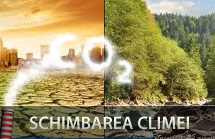For Earth's climate system, 2011 was an extraordinarily turbulent year. The United States saw a series of record-busting extremes, from a devastating tornado season to an epic drought in a vital agricultural region. The fusillade of extreme events kept global warming in the public conversation even as it slipped to the bottom of the public's list of concerns in the face of a grim economy, and as "climate" became a four-letter word in Washington.
Scientists made tangible progress in the emerging area of extreme event attribution, which aims to answer whether extreme weather events can be attributed to climate change, with two studies that shed new light on how a warmer world is already shifting the odds in favor of heavy precipitation events. These studies, and the push to develop the capabilities necessary to rapidly distinguish global warming's role in extreme events soon after they occur, top the list of the top climate change stories of 2011:
1. Advances in understanding global warming and extreme weather
Two studies published in February in the journal Nature made it a lot clearer that manmade global warming is already playing a tangible role in influencing some types of extreme weather events.
One study, led by researchers with Environment Canada, analyzed heavy rainfall events recorded at more than 6,000 sites across the Northern Hemisphere, and found that the growing amount of heat-trapping gases in the atmosphere have likely increased the frequency of heavy precipitation events across this region.
The second study demonstrated a new way of analyzing how manmade global warming may have increased the chances for a particular flood that occurred in the U.K. in 2000. The high-resolution computer model used for the study showed that global warming increased the risk of the 2000 flood event by at least 20 percent, with two-thirds of the computer model simulations showing a much larger increase in flood risk, by up to 90 percent.
As I detailed in September, climate scientists are moving forward with plans to form an international extreme events attribution group, which will focus on advancing this type of work.
Also on the extreme events front, in November, the U.N. Intergovernmental Panel on Climate Change released a "Special Report on Managing the Risks of Extreme Events and Disasters to Advance Climate Change Adaptation."
As CWG's Jason Samenow reported:
The report by the United Nations Intergovermental Panel on Climate Change makes clear that warm weather extremes and heavy precipitation events have increased, most likely as a result of manmade climate change. And it projects with a high degree of confidence increasing hot weather and heavy downpours in the future.
2. Surface temperature record holds up to (another) review
For years, global warming skeptics sought to cast doubt on the surface temperature record. Some said warming was an artifact of the urban heat island effect - which can raise temperatures in urban areas compared to rural locations - rather than increasing concentrations of greenhouse gases. Others pointed to inconsistencies in correcting for gaps or biases in the data. A web-based movement formed, with a small army of volunteers documenting the locations and setup of official weather stations.
In response to numerous questions about the surface temperature record, a blue-ribbon panel was organized to find out once and for all if the Earth is really warming, and by how much. The panel was led by physicist Richard Muller of the University of California-Berkeley, who had expressed skepticism about mainstream climate science findings in the past, and some of the money for the panel came from politically conservative-leaning groups.
In the end, though, the Berkeley Earth Study, confirmed what most climate scientists already knew - the surface temperature data is correct in showing a pronounced warming trend. To be specific, the analysis found there has been 0.911 degrees Celsius of land warming (+/- 0.042 C) since the 1950s, or about 1.8 degrees Fahrenheit.
The Berkeley study analyzed data from more than 39,000 weather stations, more than five times the 7,280 stations found in the Global Historical Climatology Network Monthly data set (GHCN-M) that has served as the foundation of many other climate studies. The researchers employed new statistical methods that, the team says, more accurately take into account discontinuities in the data as well as data quality questions...
The Berkeley team's analysis strongly refutes claims that the urban heat island effect causes a warm temperature bias in the surface data. The researchers also found that despite the skeptics' assertions, readings from networks of temperature stations are not compromised by poor data quality from many of the individual stations.
3. "Climategate 2" falls flat
For the thousands of experts who study the climate, 2011 was something of a rebuilding year - a chance to regroup from the turbulence caused by the so-called "climategate" emails scandal. After multiple investigations cleared climate scientists of the most serious allegations of wrongdoing, more emails between a few top climate researchers were released, again purporting to show climate scientists doctoring scientific evidence and conspiring to keep out dissenting voices from peer-reviewed journals. This time, however, the damage to climate science's street cred was minimal, as the media and the scientific community quickly found the emails to lack much evidence of anything scientifically significant.
The unauthorized release of the new batch of emails may have jump-started what seemed to be a dormant investigation into who obtained the emails and posted them on several websites, with actions by law enforcement agencies in the U.S. and Britain.
4. Congress Nixes National Climate Service
The 2010 midterm elections brought into power a surge of House lawmakers who either strongly questioned or flat out denied the existence of manmade climate change. As a result, the gap between climate scientists and politicians became wide enough to swallow what were once thought of as common sense, bipartisan ideas - such as creating a National Climate Service within the National Oceanic and Atmospheric Administration (NOAA) to complement the National Weather Service. Under the proposal, which was originally put forward by the Bush administration, the Climate Service would serve as a one-stop shop for climate info, from El Nino forecasts to projections of what the climate may be like 50 years from now.
The proposal called for realigning NOAA's offices and functions to meet the increasing demand for climate information from farmers, businesses, investors and others who currently must navigate an alphabet soup of NOAA organizations to find the information they're looking for, and to develop new climate analysis products and tools. NOAA requested no new money for the move, instead seeking congressional approval to restructure itself.
House Republicans blocked the move, and even sought to investigate whether NOAA was moving forward with the plan against its wishes. (For more background info, see this Post story by Brian Vastag).
The death of the Climate Service proposal was presaged by a vote last spring that put House members on record about whether they agree with the scientific evidence showing that the globe is warming, likely due in part to human activities.
The amendment, which was offered to a bill aimed at halting proposed U.S. EPA greenhouse gas regulations, stated: "Congress accepts the scientific findings of the Environmental Protection Agency that climate changes is occurring, is caused largely by human activities, and poses significant risks for public health and welfare."
As I wrote at the time: "From a scientific perspective, the amendment's language was rather benign. It was not a climate alarmist statement, nor did it overstep the science as expressed by highly-regarded research groups, not to mention the trove of peer reviewed scientific studies on climate change that seem to multiply by an order of magnitude each week."
The fact that it failed by a vote of 184 to 240 (three Democrats were among those who rejected the amendment; one Republican supported it) signals the depth of the problem that scientists, environmental policy advocates, environmentalists, and others face in pushing for climate change action at the federal level. A majority of one chamber of the Congress just does not agree with the conclusions of most publishing climate scientists. This is a remarkable turn of events, considering that the last Congress narrowly passed a sweeping greenhouse gas regulation bill, which died in the Senate.





